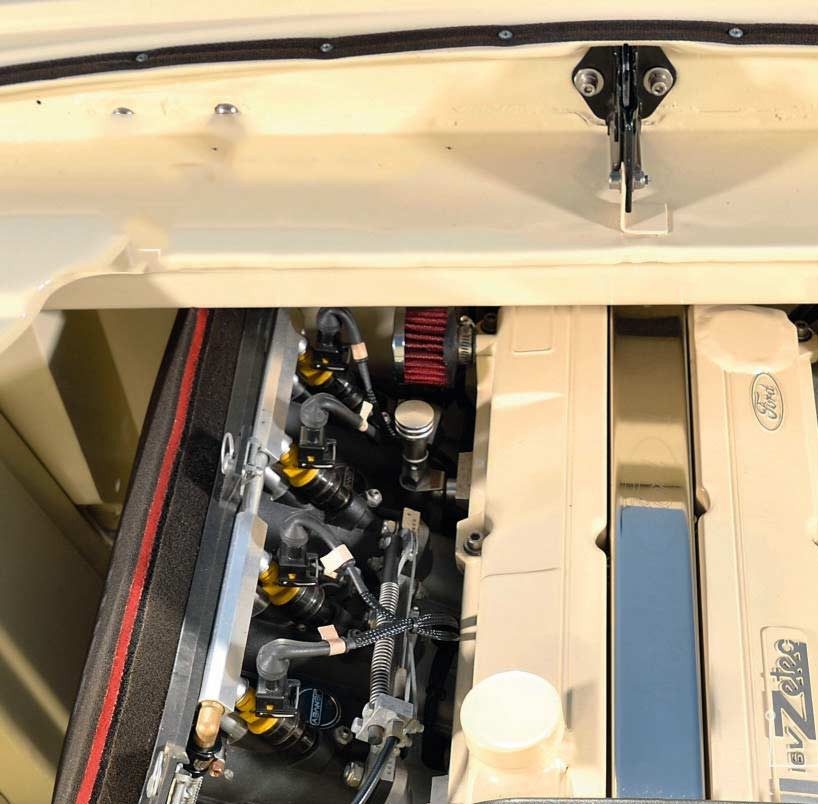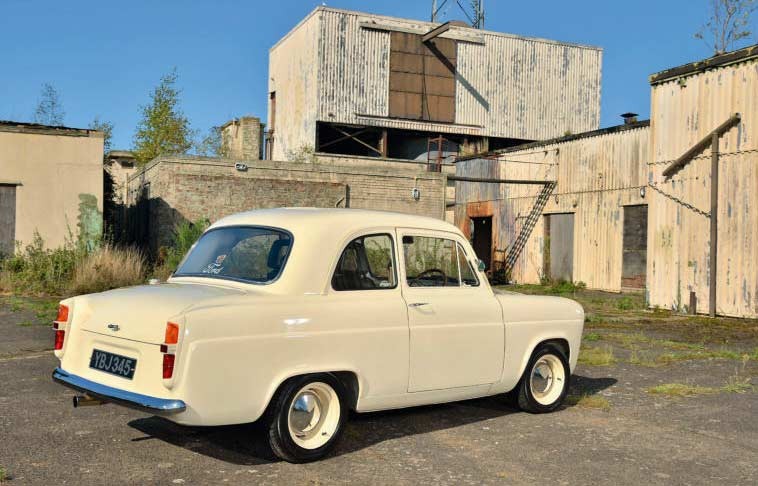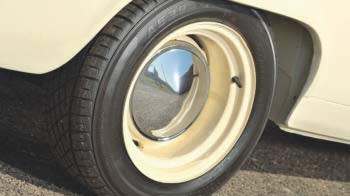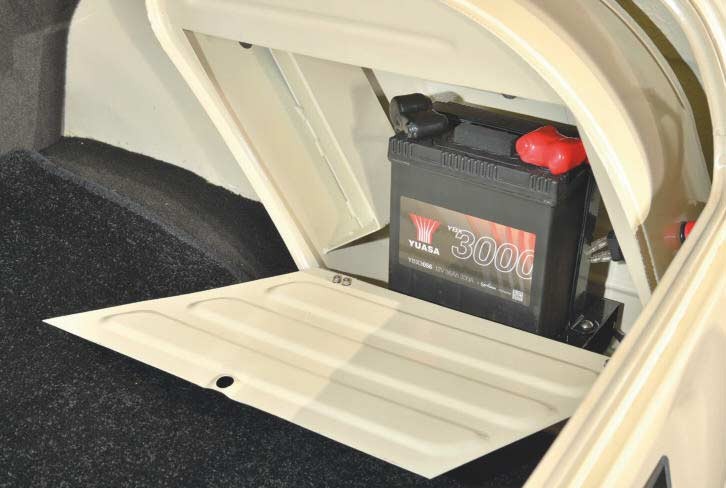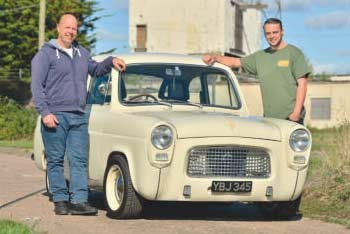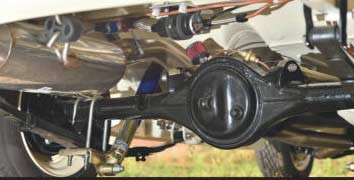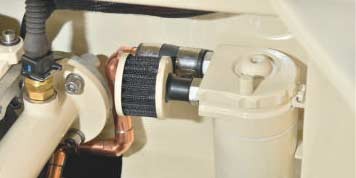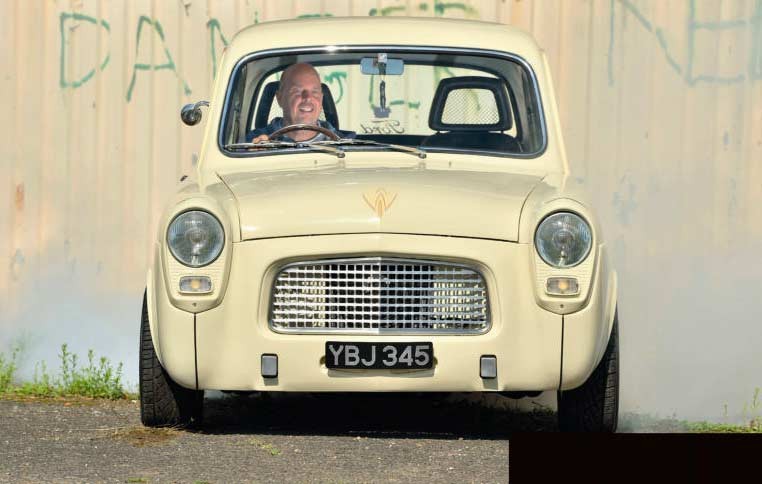ZETEC ANGLIA 100E
It took two attempts, but Dave Caley finally made this year’s Great Unveiling with his incredible 100E — and it’s packed with power.
So many projects fall by the wayside. Whether it’s running out of money, time, patience or even storage, we dread to think what the success rate of completed homebuilt projects is.
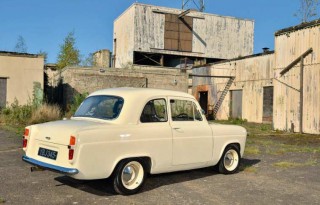
This 1958 100E, affectionately named Dolly, almost suffered that fate on several occasions, but six years after starting it, Dave Caley finally finished this outstanding Anglia, and in time for The Great Unveiling, too — even if it was his second attempt at doing so!
Dave’s first car was a Mk1 Escort when he was 17, and that car sowed the seeds for a love of Fords ever since — to the extent that he’s only ever owned Blue Ovals, and mainly Transits at that. “I did have Toyota for about three weeks once, but that doesn’t count,” he grins. After messing about with classic British bikes for years, back in 2013 Dave decided he wanted to build something a bit different, and started scouting around for a suitable project. “I’ve always loved the simple shape of the 100E — if you asked a child to draw a car, that’s what they would come up with, a classic three-box design — plus they do make for a great hot rod.
“This one belonged to a friend of mine. He’d had it for almost a decade and it was just sat there doing nothing, so I convinced him I was the person to bring it back to life. It’s always been a local car, and we think may have been owned by a couple of US serviceman at one point, as we found an old logbook with RAF Bentwaters as the address under the back seat.”
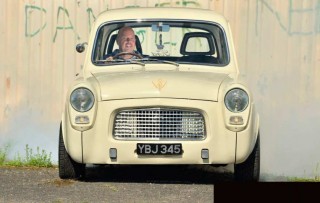
“I had a pretty good idea of what I wanted to do with the car from the start — in fact, I bought the Zetec engine before the car — but there was an awful lot of work to do before that. Even before it was stripped down, I could see the body wasn’t great. I took the shell off to be blasted and it came back with holes in the rear quarters, sills, floor, and the lower corners of the front wings… nothing I couldn’t tackle, as I work in the motor trade and learnt to weld as a youngster. Luckily, repair sections for these areas are readily available for the 100E now and I bought some from Ex-Pressed Steel Panels, which fitted up a treat.”
Once the basic shell was solid again, Dave tuned his attention to the front end — specifically making room for the Zetec in the engine bay.
“I had to do the usual stuff,” he recalls. “Make up a new bulkhead and gearbox tunnel — it wasn’t too difficult, really, I just took my time and made lots of measurements.”
With the bodyshell ready for paint, like many of us, Dave elected to get it done by a bodyshop rather that try and do it himself. “This is where it all started to go wrong,” he groans. “The first guy had it for seven months and did nothing with it. I took the shell back and found someone else, who then did exactly the same thing! By this point I was utterly fed up and was going to chuck it in — this was definitely the lowest point of the build. But my partner, Teresa and son, Adam persuaded me to keep going, so I found someone else, and two months later the shell was in paint.”
With no real idea of the Anglia’s original colour, Dave took a sample down to a paintshop, and the closest match he could find was a Fiat beige — it may be a modern shade, but it looks perfectly period on the 100E.
Blast off
With the shell away for so long, Dave had plenty of time to prepare the running gear. The 2-litre Zetec originally came out of a Mondeo, and was stripped down to a bare block before being sent off to be media-blasted, then rebuilt by Dave with standard internals, with Dave adding a set of ARP rod bolts for good measure. Around this time he came across a set of second-hand 45 mm Jenvey throttle bodies on an inlet manifold for sale, so these were quickly snapped up, with Dave sourcing an Emerald ECU to suit later. “It’s reliable but not too wild,” explains Dave. “Having said that, when the car was later mapped at Emerald on their rolling road, it made 186 bhp, which I’m well-pleased with!” A good Type-9 five-speed was then picked up, Dave adding a lightened flywheel and one of Retro Ford’s hydraulic clutch kits at the same time.
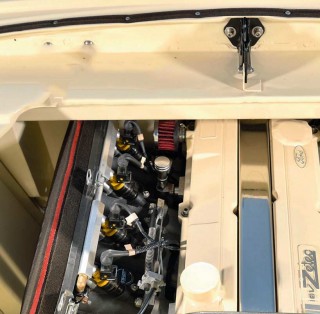
Of course, once you start modifying a 100E, you find that everything needs upgrading, and Dave elected to go for an Escort-based set-up at the front, giving him rack-and-pinion steering and better brakes. At the rear, an Anglia 105E axle was adapted to fit, giving the 100E wider drums — and the chance to install a limited-slip diff. Once the spring saddles had been moved, the axle was bolted up with GAZ dampers and the standard leaf springs, though these have been retempered by Midland Road Springs.
Going inside
With the Anglia sitting on all four (now banded) wheels again, Dave could turn his attention to the interior — and he spent almost as much time and thought putting this together as the engine bay. “It was always going to be a road car, so I wanted to make it as comfortable as possible. I originally went for a pair of low back buckets but we couldn’t get on with them, so they were quickly swapped for a pair of fishnet Recaros, which are much more suitable. I bought new covers for these from Aldridge and then took them down to a local guy who fitted then and recovered the rear seat to match. Kevin at Car Glass & Trim then fitted a new headlining, coming over to the house a couple of evenings one week to do it. It was amazing to watch him methodically fit it — I just wouldn’t have the patience to be able to do it.”
Dave sourced some new, classic Smiths gauges with modern internals, and these were installed in the Anglia’s dash while he added some neat push-button switches to the dash rail, too. With a woodrim steering wheel, new door cards from East Kent Trim, and carpet added, the interior was almost there. “The gearbox tunnel was looking a bit bare though,” explains Dave.
“Then at a hot rod show we came across a lady doing pinstriping, and she added a design there and then to the top of the tunnel — that was the finishing touch.”
Close connection
With a summer of shows and roadtrips now behind the Anglia, Dave and Teresa are finally enjoying the fruits of this six-year build, and while Dave has never been one to hang onto cars (or vans) before, this one is firmly staying put. “I’m building a proper garage for it at the moment,” he admits. “It used to live in a lean-to, but it deserves better than that. We’ll never sell it, it’ll be passed on to Adam at some point, because it turns out this car could have a family connection. It was originally sold by Mann Egerton, the Ford main dealers in Ipswich and my Dad worked in the service department at the time. Sadly, he’s no longer around to confirm this, but it’s highly likely he would have worked on the Anglia at some point. Although he wasn’t into modified cars, he would have loved Dolly.”
“I HAD TO DO THE USUAL 100E STUFF — FABRICATE A NEW BULKHEAD AND TUNNEL. IT WASN’T TOO DIFFICULT, I JUST TOOK MY TIME”
The 100E’s finish is impeccable, but as you can see, Dave’s not afraid to use it! Stronger 105E axle sorts the rear end. Dave retained the original leaf springs but had them retempered to suit. Banded, colour-coded steels maintain the clean look.
Wood rim steering wheel and Smiths’ gauges
are modern interpretations of classic designs. Interior is specced with road trips in mind: retrimmed Recaros, relocated switchgear and proper gauges. Pinstriping on the tunnel and glovebox lid is the finishing touch.
Above: note the copper fittings! Below: Dave had loads of support from family with the car including son Adam.
Spare fuel tank was adapted to house the battery and mounted opposite the original tank, for a super-symmetrical boot…
BAY WATCH
DAVE’S APPROACH TO PLANNING
“I probably spent more time on working out the layout of the engine bay that anything else,” reckons Dave, and it shows. The brackets and tanks have been colour coded to the body to make them less obvious, and the wiring loom has been carefully hidden, with just the throttle cable now exposed. The alloy radiator, a custom item that replicates the original, bolts up to the standard platforms. Dave took the 100E over to exhaust specialists, Demand Engineering to make up a stainless steel manifold that hugs the side of the engine as closely as possible (and which leads to a full stainless system), which just left the biggest challenge — relocating the master cylinders.“ They live inside the car now, and took a bit of working out and fabrication —they were a right fiddle to fit, but I’m pleased with how they’ve turned out.”
As with almost all modified 100Es, Dave had to fabricate a new bulkhead, but kept the original ‘shelf’ to keep the factory appearance, chassis mounting the engine so that it would sit underneath it. Hiding the HT leads under this cover was a simple task, but Dave then went on to relocate all the engine bay loom, leaving just the throttle cable and injector plugs on show — he’d of hidden those too, if he could! 45 mm throttle bodies were a second-hand bargain, and breathe through a super-slim filter.
Dave had to rebuild the 2-litre Zetec twice after he found the oil ways were partially blocked. Now the engine is in rude health — to the tune of 186 bhp.
Uprated alloy radiator mimics the width of the original but the larger core means it can cope with keeping the Zetec at the right running temperature.
LIFTING THE COVERS
DAVE’S GREAT UNVEILING
Dave’s 100Ewas originally pencilled in for the 2018 Great Unveiling, but fate had other plans — just six weeks before the show. “I fired it up for the first time and had it ticking over, but it just didn’t sound right — I had no option but to take the engine out and strip it down again. When I did, I found there was material all down the oil ways. The oil pump was wrecked and I had to replace the shells, but the pistons and rings were fine — the bores just needed a hone.” This set Dave back though, and he had no option but to pull out of the 2018 Unveiling. “I shut the garage door and decided to save the car for 2019 instead.”
Fast-forward 10 months, and Dave wasn’t taking any chances. “There was a big push to get it finished, and the car was ready in good time, though it hadn’t been dyno’d at that point.”
“I was really nervous on the day, and as the cover came off went through all kinds of emotions — after six years of ups and downs the project had really got to me. But the reaction was great, and I loved watching people’s faces as they crawled all over the car.”
BUILD LOG

Six years of graft with a few setbacks thrown into the mix, saw Dave finally finish the Anglia this Summer
A local car all its life, Dave bought the 100E from a friend after it had been laid up for many years. Once the shell was stripped, Dave sent it off to be blasted, revealing plenty of rot in the lower sections. This included Escort-based front suspension, giving the Anglia much-needed rack-and-pinion steering. At the rear, Dave altered the spring saddles on a 105E axle and bolted that up with the 100E’s springs, along with anti-tramp bars and GAZ dampers — a much better (and safer) set-up.
While Dave busied himself making the shell good again, he also set about dry-fitting the uprated running gear.
HIDDEN CHARGES RELOCATING THE BATTERY
There are so, so many lovely details on Dave’s 100E from the flush-mounted switchgear in the dash to the pinstriping, but our favourite has to be the battery location – hidden inside a dummy fuel tank! “There was no room in the engine bay so I had to move it, but I didn’t want it on show — I had to hide it somewhere! I had a spare fuel tank in the corner of the garage, and I kept looking at it and thinking, I wonder… I measured it up and it was wide enough, so I put a 1mm cutting disc on the angle grinder and very gingerly cut a door out of the side. It wasn’t easy to do the whole conversion, making the door and mounting the battery, and I probably spent way longer doing it that I should have done, but it worked out in the end, and I’m quite pleased with how it’s turned out. It makes for a great talking point at shows, too.”
Tech Spec
Body 1958 Ford Anglia 100E, extensively restored, debumpered front. Paint: Fiat beige with pinstriping
Engine Chassis-mounted 2-litre Silver Top Zetec, rebuilt, ARP rod bolts, Retro Ford alloy sump, Jenvey 45mm throttle bodies, Demand Engineering 4-2-1 manifold and system, Emerald ECU, uprated alloy radiator, Sytec fuel pump and filter.
Max Power 186 bhp @ 6000rpm
Max Torque 156lb ft @ 3000rpm
Transmission Type-9 five-speed gearbox, lightened flywheel, Retro Ford hydraulic clutch kit, custom prop, Anglia 105E axle, 3.7:1 final drive ratio, gear-type LSD
Suspension
Front: Escort struts converted to coil-overs, GAZ inserts, adjustable track control arms, Escort anti-roll bar, Escort rack
Rear: GAZ dampers, retempered leaf springs, 2 inch lowering blocks, A-frame
Brakes
Front: Wilwood four-pot callipers, 247 mm solid discs
Rear: 105E Super drums. Reverse-mount pedal box, Wilwood master cylinder, line lock, Goodridge lines
Wheels and tyres Original steels banded to 7×13 (front) and 7.5×13 (rear), with 1745/60R13 (front) and 185/60R13 (rear) A539 tyres
Interior Recovered RS2000 fishnets, rear seat trimmed to match, new doorcards and headlining, woodrim steering wheel, electronic gauges mounted in original dash, push-button switchgear mounted on dash panel, battery relocated to boot hidden inside dummy fuel tank
Thanks My partner, Teresa, son Adam, good friend Stuart Gillespie, Lee at Crisp Engineering (www.crispengineering.co.uk), Midland Road Springs (https://leafsprings.co.uk), GAZ Shocks(www.gazshocks.com), Demand Engineering (01473 890 820, https://demandengineering.co.uk), Kevin at Car Glass & Trim (01473 214611, www.carglassandtrim.co.uk), Aldridge Trimming (www.aldridge.co.uk), Ex-Pressed Steel Panels (www.steelpanels. co.uk) and East Kent Trim Supplies (www.classiccar-trim.com)

